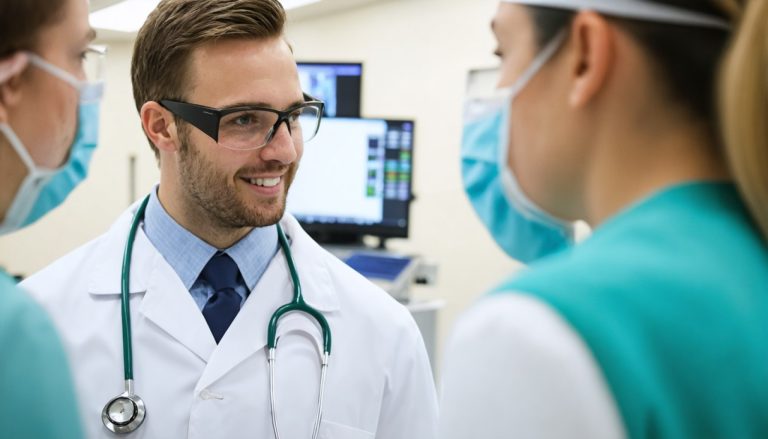
- Arkansas Tech University (ATU) and St. Mary’s Regional Health System are forming a strategic partnership to enhance medical education and practice in the region.
- The collaboration aims to bridge the gap between academic learning and clinical application, adapting to the evolving demands of the healthcare industry.
- ATU plans to develop a flexible curriculum that integrates cutting-edge medical knowledge and practical skills for emerging healthcare roles.
- St. Mary’s emphasizes the need for continuous refinement of educational programs to meet healthcare’s dynamic needs.
- Through this partnership, students gain exposure to state-of-the-art medical technologies and patient care strategies, linking theory with practice.
- The alliance underscores the potential of educational-healthcare collaborations to shape the future, benefiting both students and communities.
- The commitment to innovation and open dialogue aims to enhance opportunities and elevate care standards in the region.
Arkansas Tech University (ATU) and St. Mary’s Regional Health System find themselves on the precipice of a groundbreaking partnership poised to redefine the region’s medical and educational landscape. The meeting between ATU representatives and St. Mary’s leaders wasn’t just a mere exchange of pleasantries; it was a vivid tableau of ambition and collaboration, set against the backdrop of an ever-evolving healthcare industry.
In the austere meeting room, where innovation met tradition, conversations flowed with the same vitality as the nearby Arkansas River. At the heart of their discussion was the recognition of modern healthcare’s rapidly shifting demands. As the medical field adapts to new technologies and practices, so too must the institutions that supply its workforce. ATU, with its commitment to educational excellence, and St. Mary’s, a beacon of healthcare in the region, converged on the idea that a synergistic approach could bridge the gap between academia and clinical practice.
The dialogue unearthed a keen understanding that the medical field’s employment landscape is shifting. Emerging roles in healthcare demand unique skill sets that didn’t exist a decade ago. The ATU team, energized by this revelation, envisions an adaptable curriculum that equips students with cutting-edge knowledge and practical skills. Meanwhile, St. Mary’s representatives candidly shared their forecasts for healthcare, emphasizing the necessity for educational institutions to refine their programs continuously to meet these dynamic needs.
Post-meeting, the ATU contingent traversed the halls of St. Mary’s Regional Medical Center. The experience was not merely observational; it was transformative. The tour illuminated the inner workings of state-of-the-art medical technologies and patient care strategies, offering a tangible connection between academic theory and real-world application. The hum of medical equipment and the distant chatter of caregivers formed a symphonic backdrop to the day’s revelations.
This alliance between ATU and St. Mary’s exemplifies a powerful synthesis of education and healthcare. It underscores a crucial message for communities far and wide: when educational institutions and healthcare facilities join forces, they don’t just prepare for the future—they shape it. With shared visions and open dialogue, ATU and St. Mary’s Regional Health System are charting a course that promises to expand opportunities and uplift the standard of care, echoing their commitment to nurturing a healthier, more educated society.
The promise of this partnership is clear—through innovation and collaboration, they are laying the foundation for a future where both students and patients thrive.
How a New Partnership is Revolutionizing the Healthcare Education Landscape
—
Introduction
The burgeoning collaboration between Arkansas Tech University (ATU) and St. Mary’s Regional Health System is setting a new precedent in the medical education and healthcare sectors. This initiative goes beyond mere agreements, catalyzing advances in both educational and healthcare environments by aligning their objectives to prepare students for the demands of modern healthcare roles.
—
New Insights and Predictions
1. Adapting to Evolving Healthcare Roles
The collaboration highlights the urgency in adapting educational programs to keep pace with evolving healthcare roles. More complex and diverse positions such as telehealth coordinators, healthcare IT specialists, and genetic counselors are emerging as staples in the industry. Programs must be dynamic, continually integrating new technologies and practices.
2. Incorporating Real-World Use Cases
ATU’s embrace of experiential learning, fueled by the partnership, suggests a pedagogic shift where academic curricula are interlinked with practical applications. This hands-on approach can significantly enhance the students’ readiness for real-world challenges, creating a workforce adept not only in theoretical understanding but in practical implementation.
3. Market Forecasts and Trends
The global healthcare education market is projected to expand, particularly with an emphasis on online learning and telehealth training burgeoning out of necessity. This trend aligns with ATU and St. Mary’s innovative framework, which could serve as a model for similar institutions striving to modernize education in line with industry demands.
4. Security and Sustainability in Healthcare
St. Mary’s exemplifies a sustainable, integrative healthcare model by investing in the latest medical technologies and sustainable practices. This sets a benchmark for healthcare systems aiming to lower their environmental impact while maximizing operational efficiency.
5. Actionable Recommendations and Quick Tips
– For Educational Institutions: Maintain agile curriculum development frameworks to quickly incorporate emerging medical technologies and practices.
– For Healthcare Facilities: Establish partnerships with educational providers to ensure a steady influx of well-prepared professionals.
– For Students: Engage with institutions that offer experiential learning opportunities, as these significantly improve career readiness.
—
Life Hacks and How-To Steps
– How to Enhance Career Opportunities in Healthcare:
1. Stay Informed: Keep updated with emerging healthcare technologies and methodologies through workshops, seminars, and courses.
2. Embrace Networking: Collaborate with peer groups and professionals within the healthcare sector to gain insights and job referrals.
3. Continuous Learning: Engage in lifelong learning through certifications, advanced courses, and professional development opportunities.
—
Reviews and Comparisons
– Benchmarking Against Peer Institutions: Evaluating how ATU’s curriculum adaptation strategies compare to other universities shows a competitive edge, as few institutions have integrated such tight-knit collaborations with health systems.
—
Controversies and Limitations
The rapid evolution of healthcare roles can create challenges. There’s a need to strike a balance between innovation and maintaining foundational medical education standards. Critics may argue that such rapid curricular updates can lead to inconsistencies in educational quality.
—
Related Links
For more information about Arkansas Tech University and its initiatives, visit their official site: Arkansas Tech University.
To learn more about St. Mary’s Regional Health System, you can visit their official site: St. Mary’s Regional Health System.
—
Conclusion
This groundbreaking partnership between ATU and St. Mary’s Regional Health System demonstrates the power of combining academic rigour with practical application to shape a forward-thinking healthcare workforce. By focusing on flexibility, innovation, and experiential learning, they are setting a template for progressive educational practices in line with the shifting landscape of global healthcare needs.



